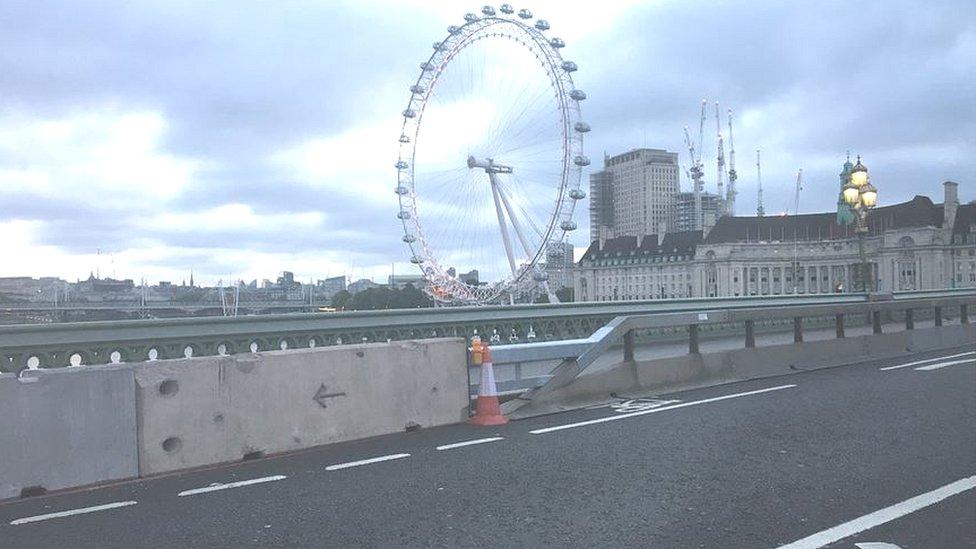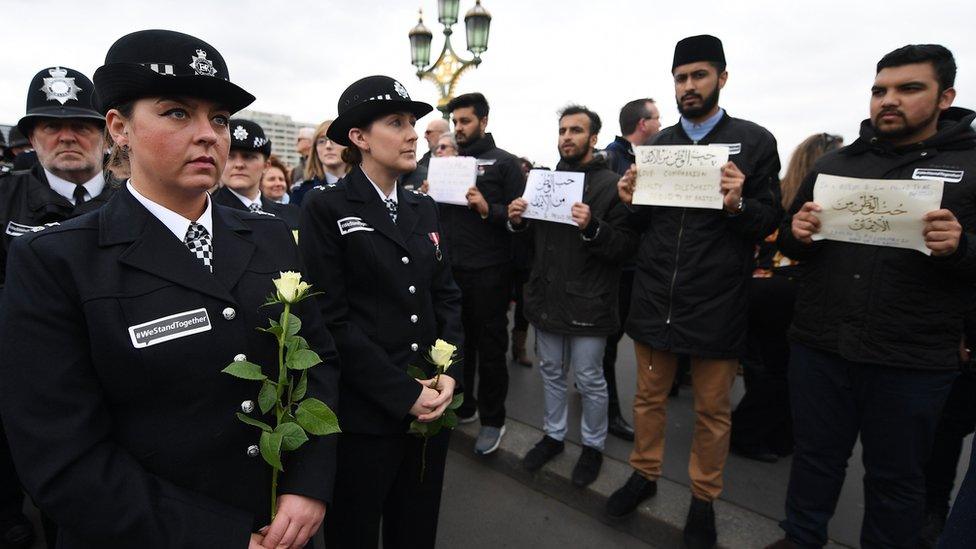Building barriers - a new normal for London?
- Published
- comments

A number of bridges now have "increased security measures" such as barriers
It happened quickly, just over 24 hours after the atrocious attack at London Bridge.
The barriers appeared overnight and now a number of bridges in London have what the Metropolitan Police is calling "increased security measures".
The Met has reviewed all 33 of the capital's bridges and, as a result, it quickly began installing protective barriers.
A spokesman told me: "Since the night of Sunday, 4 June we have had protective barriers installed at Westminster Bridge.
"We are in the process of having barriers installed on Waterloo Bridge and Lambeth Bridge to maintain security at these venues.
"We recognise the public is anxious about security following the terrorist attacks in London, and we want to reassure them that we are taking precautions to make the Capital a safe place for people to live, work and visit.
"The barriers are intended to increase security on what are some of London's busiest bridges. They are designed specifically for hostile vehicle mitigation and are a national asset used around the UK.
"We are considering the use of barriers and other security measures at locations across London. We will not be discussing this further at this time."
So why introduce them now?
As the Met states there have been two appalling incidents in the past few months where the capital's bridges have been targeted and, in both cases, the assailants used vehicles as deadly weapons.
The reason? One security expert Will Geddes has a theory that bridges are being targeted, as they give a reference point for the publicity that terrorists crave. Many people will have heard of London or Westminster bridges.
Widely supported
So maybe these barriers or Vehicle Security Barriers (VSBs) are a deterrent, perhaps they are meant to be reassuring. Although, as many people point out, you cannot put barriers everywhere.
It's very difficult to ascertain how long they will be in place. I'm told they are temporary but as they have not impeded the traffic flows on the bridges, Traffic Regulation Orders (TRO) have not been needed to implement them.
The authorities I've spoken to have been very supportive of the move.
But while Transport for London (TfL) closed the roads for the work to happen, along with Westminster Council, it would not be in a position (even if it wanted to) to stop the works.
It seems the Met has the powers to introduce these kind of measures unilaterally.
It looks like the barriers are of a type called Varioguard which is according to the companies website a "temporary steel highway safety barrier system" with "unique energy absorbing features and enables rapid installation".
Westminster Council wants more barriers and bollards: "People in Westminster need this kind of protective measure - it is sensible and proportionate. We are working closely with the Metropolitan police and security services and are happy to assist on measures like planning and traffic management. The kind of security barrier now in place on Westminster Bridge needs to be part of a permanent solution."

Note that the council implies that so far it has not been involved in planning and traffic management.
But if these are kept long term it will have an impact on some road users that use London's bridges. Some cyclists are concerned it will mean their road space will be squeezed and the barriers could be a hazard.
The London Cycling Campaign, external says: "The London Cycling Campaign is fully supportive of the Met, TfL and the boroughs involved taking urgent steps to provide extra protection for Londoners and visitors to our city.
"It is also important we do not allow this attack to impede people going about their business, including being able to cycle around the city.
"We will be talking to all the relevant bodies about how measures, such as new barriers on the bridges, can provide the extra security needed as well allow people, especially Londoner's large number of cycling commuters, to continue cycle safely with minimal disruption."
The solution long term is often bollards which pedestrians can walk between and still offer security against vehicles.
As London adapts to different threats, additions to protect against terrorism will also need to be as practical as possible.
- Published5 June 2017

- Published5 June 2017
- Published29 March 2017
